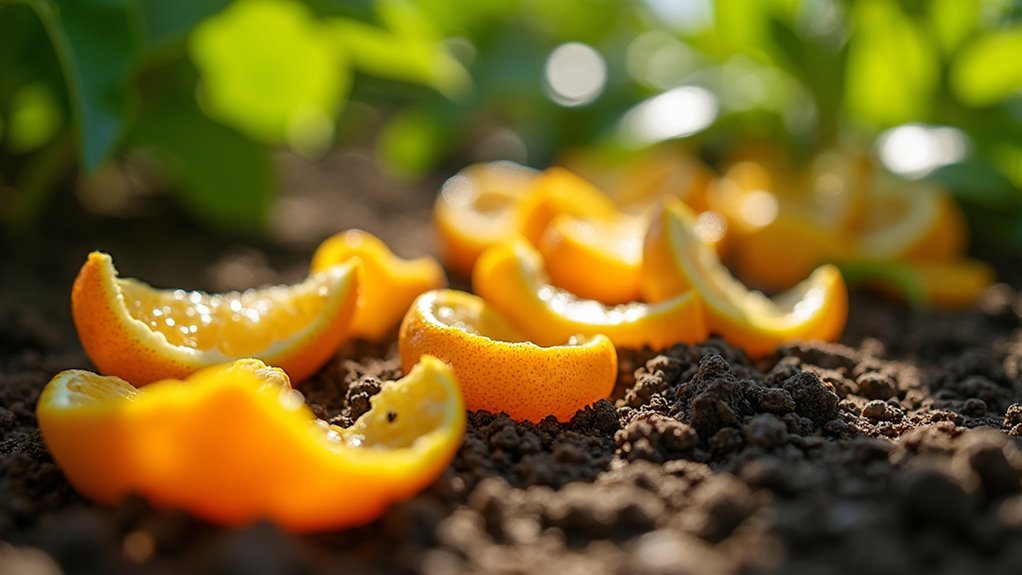Citrus peels stop garden pests because they’re loaded with limonene, a natural compound that’s toxic to insects but completely safe for your plants. When you place orange or lemon peels around your garden, the strong citrus scent masks the natural odors that attract pests and disrupts their ability to locate food sources. The acidic oils also interfere with ants’ pheromone trails and create an unwelcoming environment for slugs, aphids, and fruit flies. You’ll discover the most effective application methods below.
The Science Behind Citrus Pest Deterrence

While chemical pesticides dominate garden centers, citrus peels offer a natural alternative that’s backed by science. When you use orange peels as a deterrent, you’re leveraging limonene, a powerful compound that makes up the peels’ essential oils. This chemical is toxic to insects but completely safe for your plants and animals.
The science works through disruption of insects’ primary navigation system: smell. Pests rely heavily on scent to locate food sources, and citrus aromas effectively mask the natural odors that attract them to your garden. This olfactory interference causes insects to lose their ability to detect suitable feeding spots.
Fresh peels work best since limonene evaporates quickly. You’ll need to replace them regularly to maintain their effectiveness and continue to repel unwanted garden visitors.
Which Garden Pests Citrus Peels Repel Most Effectively
Though citrus peels won’t eliminate every garden intruder, they excel at repelling specific pests that plague most home gardens.
You’ll find citrus peels particularly effective against slugs, which hate crawling over the acidic surfaces. Aphids and whiteflies can’t tolerate the strong citrus scent and will avoid treated areas.
Orange peels work exceptionally well against fruit flies that typically swarm around ripening produce and compost areas. Ants also steer clear of citrus-treated zones since the oils interfere with their pheromone trails.
While these peels repel pests naturally, they simultaneously break down to add nitrogen to your soil. This dual-action approach makes citrus peels an eco-friendly solution that protects your plants while enriching your garden’s foundation.
Creating Your Own Orange Peel Spray Solution

Creating your own orange peel spray solution transforms kitchen scraps into a powerful pest deterrent that’s both economical and effective.
Start by boiling fresh orange peels in water for ten minutes to extract essential citrus oils. After cooling, strain the mixture to remove peels, ensuring smooth application. Transfer the liquid into a spray bottle for convenient use throughout your garden.
Boil orange peels for ten minutes, strain the cooled mixture, and transfer to a spray bottle for easy garden application.
Apply this solution every 3-4 days to maintain the strong citrus scent that effectively repels pests like aphids and ants.
For enhanced effectiveness, consider soaking orange peels in vinegar for 1-2 weeks before boiling. This simple preparation increases the spray’s pest-repelling properties, making it even more powerful against unwanted garden visitors while remaining completely natural and safe.
Strategic Placement of Fresh Citrus Peels Around Plants
You’ll get the best pest control results by placing fresh citrus peels directly around your plants’ base perimeter, creating an aromatic barrier that deters slugs, aphids, and fruit flies.
Chop the peels into smaller pieces to increase their surface area and boost the citrus scent’s intensity.
Replace dried-out peels with fresh ones regularly, since the protective aroma weakens over time and loses its pest-repelling power.
Optimal Peel Placement Zones
Strategic placement of fresh citrus peels can dramatically boost their pest-deterrent power in your garden.
You’ll want to position orange peels directly around plant bases where slugs, aphids, and fruit flies typically congregate. Focus your placement efforts in high-traffic pest areas like vegetable gardens and flower beds to maximize the deterrent effect.
For best results, use chopped-up peels rather than whole ones. Smaller pieces increase surface area, allowing the citrus scent to disperse more effectively throughout these critical areas.
Keep peels away from shaded or damp zones where mold develops, as this attracts unwanted pests and reduces effectiveness.
Replace your peels every few days to maintain their potency and continue repelling garden invaders.
Freshness and Replacement Timing
While citrus peels offer excellent pest control benefits, their effectiveness depends entirely on maintaining peak freshness levels.
Fresh orange peels deliver the strongest citrus scent that repels garden pests, but you’ll need to replace every 3-4 days as their potency diminishes quickly.
To maintain freshness and preserve pest-repelling properties, guarantee your chopped orange peels are strategically placed in dry, sunlit areas near plant bases.
Avoid damp or shaded spots where mold can develop and prevent attracting unwanted wildlife to rotting peels.
Time your replacement schedule around seasonal pest activity patterns—you’ll maximize impact during peak infestation periods when aphids and ants are most active in your garden.
Maximizing Effectiveness While Avoiding Common Pitfalls

You’ll get the best results from citrus peels when you apply them correctly and maintain their potency over time.
Fresh peels work markedly better than dried ones, so you’ll need to replace them every few days to keep that strong citrus scent working against pests.
However, you must watch for unintended consequences like attracting rodents or birds, which can create bigger problems than the pests you’re trying to repel.
Optimal Application Methods
Before you scatter citrus peels randomly around your garden, understanding proper application techniques will determine whether you’ll successfully repel pests or accidentally attract them.
Orange peels deter common garden pests most effectively when you follow these essential methods:
- Direct Application: Chop or grind fresh orange peels into small pieces before placing chopped-up orange peels around plant bases. This releases maximum citrus scent while adding nutrients to your soil as they decompose.
- Liquid Treatment: Create a pest-repellent spray by boiling orange peels in water for ten minutes. Strain the liquid into a spray bottle and apply every 3-4 days for best results against aphids and fruit flies.
- Strategic Placement: Position chopped-up orange peels in well-ventilated areas with adequate sunlight to prevent mold growth. This effective way to maintain freshness guarantees your orange peel to deter strategy works consistently.
Timing and Replacement
Success with orange peels depends entirely on your timing and replacement schedule. Apply orange peels before pests arrive, ideally at the growing season’s start when they’re typically active. This proactive approach maximizes effectiveness against garden invaders.
Replace your orange peels every 3-4 days to maintain their fresh, potent citrus scent. Watch for signs of dryness—once peels lose their aromatic punch, they won’t repel pests effectively.
| Timing | Replacement Frequency | Key Signs to Monitor |
|---|---|---|
| Early season application | Every 3-4 days | Loss of citrus scent |
| Before pest infestations | When peels dry out | Mold growth appearance |
| During active pest periods | Monitor for dampness | Reduced effectiveness |
Incorporate orange peels into your broader organic pest management strategy, combining them with other natural deterrents for enhanced garden protection.
Preventing Wildlife Attraction
While orange peels effectively repel garden pests, they can inadvertently attract larger wildlife if you’re not careful with placement and maintenance.
To prevent attracting unwanted animals while still using citrus to deter pests, follow these essential guidelines:
- Remove peels promptly – Replace orange peels before mold or decay sets in, typically every 3-5 days.
- Use peels only – Never include orange flesh, as sugar content attracts rodents and wasps rather than repelling them.
- Monitor placement areas – Check seating areas and plant zones regularly for signs of wildlife interest.
Maintaining a clean garden environment is vital for successful integrated pest management.
Comparing Citrus Methods to Other Natural Pest Control Options
Although citrus peels offer a natural approach to pest control, they’re not always the most effective option when compared to other organic methods.
While citrus peels provide a natural pest control method, they often fall short compared to more effective organic alternatives.
While orange peels work as a natural deterrent by releasing scents that disrupt pest sensing, their low limonene levels make them less potent than alternatives like neem oil or insecticidal soap.
Organic insecticides such as Bt specifically target harmful insects without attracting unwanted wildlife that citrus peels might draw.
You’ll find companion plants provide more reliable protection than scattered orange peels.
Research demonstrates that boosting biodiversity through varied plantings manages pest populations more effectively than relying solely on citrus methods, which show limited efficacy against specific pests.
Long-Term Benefits for Soil Health and Garden Sustainability
Despite their limitations as immediate pest deterrents, citrus peels deliver substantial long-term advantages that transform your garden’s health and sustainability. When you incorporate these peels into your sustainable gardening practices, you’re investing in soil fertility that pays dividends for years.
Composted citrus peels provide three major benefits:
- Enhanced soil health – The organic matter improves structure and water retention while delivering slow-release nutrients.
- Natural pest control foundation – Healthier soil supports stronger plants that resist pest damage more effectively.
- Increased biodiversity – Decomposing peels attract beneficial organisms that create a balanced ecosystem.
You’ll reduce chemical pesticide dependence while building soil fertility naturally. The nutrients from citrus peels create a self-sustaining cycle where improved soil health leads to more resilient plants and better long-term pest management.
Frequently Asked Questions
Do Citrus Peels Keep Bugs Away?
Yes, you’ll find citrus peels can repel bugs like mosquitoes, flies, and ants. The limonene in fresh peels masks food scents and disrupts insects’ detection abilities, though you’ll need regular replacement for effectiveness.
Why Should You Place Orange Peels Around Your Patio?
You should place orange peels around your patio because they’ll naturally repel mosquitoes, flies, and ants. The citrus scent disrupts insects’ food detection, creating a pest-free zone for outdoor enjoyment.
Do Citrus Peels Repel Rodents?
You’ll find citrus peels can repel rodents due to limonene compounds that create unpleasant scents for them. However, you’ll need fresh peels replaced regularly, and scientific evidence remains limited.
What Animals Do Citrus Peels Repel?
You’ll find citrus peels repel mosquitoes, ants, aphids, fruit flies, and cats effectively. The limonene compound disrupts insects’ food detection while cats naturally avoid citrus scents in your garden beds.
In Summary
You’ve discovered a powerful, eco-friendly weapon against garden pests that’s been hiding in your kitchen all along. By harnessing citrus peels’ natural oils and compounds, you’ll repel unwanted insects while enriching your soil with organic matter. Whether you’re spraying homemade solutions or strategically placing fresh peels, you’re choosing a sustainable approach that protects both your plants and the environment. Start implementing these citrus strategies today and watch your garden thrive naturally.





Leave a Reply